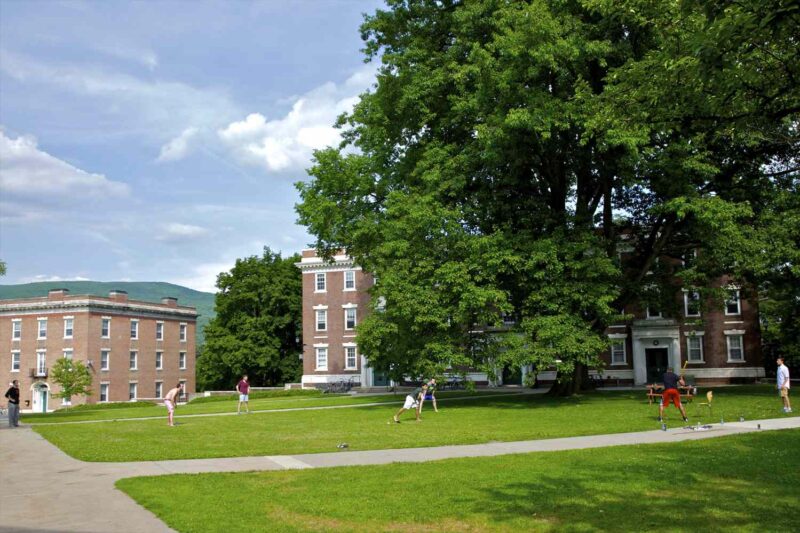Everyone talks about Harvard, Yale, and MIT when they mention New England universities. But here’s the reality: those schools reject over 95% of applicants. If you’re looking at New England for college, you need to know about schools that actually accept a reasonable number of students while still offering a solid education.
I want to share what I’ve learned about New England universities with higher acceptance rates. These aren’t the schools that make headlines, but they’re places where real students get quality education, build careers, and have good college experiences. Some of them surprised me with how much they offer.
Why New England Makes Sense
Before we get into specific schools, let’s talk about New England itself. The region includes Massachusetts, Connecticut, Rhode Island, Vermont, New Hampshire, and Maine. It’s where American higher education basically started, so there’s this deep tradition of learning and lots of established universities.
The weather is something you need to think about seriously. Winter is cold. Really cold. Snow, ice, temperatures below freezing for months. If you’ve never experienced that kind of weather, it takes adjustment. I’m not trying to scare you, just being honest about what you’re signing up for.
The region is expensive. Housing costs in cities like Boston are crazy high. Even smaller college towns can be pricey compared to other parts of America. Factor this into your planning because your money will not stretch as far here as it might in Texas or the Midwest.
On the positive side, New England has an incredible history, beautiful scenery (especially fall colors), and a concentration of educational institutions that creates this intellectual atmosphere. Public transportation is better than in most of America, which matters when you don’t have a car. The region is relatively compact, so you can visit multiple cities easily.
University of Vermont
UVM in Burlington has an acceptance rate of around 60-65%, which is very achievable compared to most New England schools. Burlington sits on Lake Champlain with mountain views, and students constantly talk about how beautiful the location is.
The university is strong in environmental sciences, which makes sense given Vermont’s focus on nature and sustainability. Business, engineering, and health sciences programs are solid, too. The school isn’t trying to be MIT, and that’s fine. It focuses on giving undergrads a good education without the pressure cooker atmosphere of more competitive schools.
Burlington is small but lively for a college town. About 45,000 people live there, and UVM students make up a significant chunk of that. The downtown area has restaurants, shops, and music venues. The city feels safe and manageable, not overwhelming like Boston or New York.
Winter sports are huge if you’re into that. Skiing and snowboarding are popular since you’re in Vermont with mountains nearby. If outdoor activities appeal to you, UVM provides lots of opportunities. If you hate cold and snow, this might be challenging.
The student body is fairly homogeneous, mostly white American students. International diversity exists, but it isn’t as strong as at larger research universities. African and international student organizations are present but smaller. This is something to consider if community matters to you.
Cost-wise, UVM is expensive for out-of-state students, running around $45,000 to $50,000 per year for tuition alone. Add living expenses, and you’re looking at maybe $65,000 to $70,000 total per year. Financial aid for international students is limited. You need to be realistic about whether this is affordable for your family.
University of Connecticut (UConn)
UConn’s main campus is in Storrs, Connecticut, with an acceptance rate typically between 50-56%. It’s a large state university with about 19,000 undergrads, so you get that big school experience with lots of options.
The business school is well-regarded, particularly for finance and accounting. Engineering programs are solid, especially mechanical and computer engineering. UConn has been investing in science and technology programs, building new facilities, and hiring faculty.
Basketball is massive at UConn. Both men’s and women’s teams have won national championships. If you want a school where sports matter and there’s school spirit, UConn delivers that traditional American college experience. Games are big social events.
Storrs is rural, which surprises some people. It’s not near any major city. Hartford is about 30 minutes away, but it isn’t exactly exciting. Boston is maybe 90 minutes, New York is about two and a half hours. Having a car helps a lot, though the campus itself has what you need.
The size of UConn means you can find your community, but you need to make an effort. With 19,000 undergrads, it’s easy to feel lost if you don’t join clubs, make friends in your dorm, or connect with people in your major. The university offers resources, but you have to seek them out.
International student support exists, with an office dedicated to helping with visa issues and cultural adjustment. The international population is growing, but still represents maybe 5-7% of undergrads. You’ll find other international students, though building community requires some work.
Financially, UConn costs about $40,000 to $43,000 per year in tuition for out-of-state students. Total cost with housing and meals pushes toward $60,000 annually. Merit scholarships exist but are competitive. Need-based aid for international students is very limited.
University of Rhode Island
URI in Kingston has acceptance rates around 70-76%, making it one of the more accessible options we’ll discuss. The campus is a few miles from the Rhode Island beaches, which is pretty nice if you like coastal areas.
Marine biology and oceanography are standout programs at URI, benefiting from the coastal location. Pharmacy is another strong program. Engineering, business, and nursing all have decent reputations. The school isn’t trying to compete with elite universities, which keeps the atmosphere less stressful.
Campus life is active with lots of student organizations. Greek life exists, but doesn’t dominate the social scene. The beach proximity means students head to the coast when the weather permits. Newport, a beautiful historic town, is nearby and worth visiting.
Kingston itself is small, basically a college town without much beyond the university. Providence is about 30 minutes away and offers more urban amenities. Boston is maybe an hour and a half. You’re not isolated, but you’re not in the heart of a big city either.
The student body is predominantly from the Northeast, with Rhode Island and Massachusetts students making up a large percentage. International students represent maybe 3-4% of undergrads. The diversity is improving, but still limited compared to larger research universities.
URI costs around $33,000 to $35,000 per year for out-of-state tuition. Total expenses run about $50,000 to $53,000 annually. This is more affordable than UVM or UConn, though still not cheap. Financial aid for international students is minimal, so plan accordingly.
University of Massachusetts Amherst
UMass Amherst has an acceptance rate typically between 60-65%. It’s the flagship campus of the UMass system and significantly larger than the other schools we’ve discussed, with over 24,000 undergrads.
The computer science program is surprisingly strong, ranked much higher than the university’s overall ranking would suggest. Engineering is solid across multiple disciplines. The Isenberg School of Management has a good reputation for business education. Sciences and liberal arts programs are respectable, too.
Amherst is a classic college town with a great vibe. The area is called the “Five College Consortium” because UMass, Amherst College, Hampshire College, Smith College, and Mount Holyoke are all nearby. You can take classes at these other schools, which expands your options significantly.
The town has good restaurants, bookstores, music venues, and that college town atmosphere students often want. It’s not a major city, but it doesn’t feel isolated either. Boston is about two hours away, which is manageable for occasional visits.
Campus resources are extensive because of the university’s size. Research opportunities exist if you seek them out. Career services, counseling, and academic support, all available. But again, with 24,000 undergrads, you need to be proactive about accessing these resources.
The international student population is more substantial at UMass than at the other schools mentioned, maybe around 8-10% of undergrads. The larger size means more absolute numbers of international students, making it easier to find a community. International student organizations are active.
Cost is around $37,000 to $39,000 per year for out-of-state tuition. Total expenses, including housing and meals, run about $55,000 to $58,000 annually. UMass offers some merit scholarships, though competition is stiff. The school provides reasonable value considering the quality of education.
University of New Hampshire
UNH in Durham has acceptance rates between 80-85%, among the highest of the schools we’re discussing. The campus is beautiful in that classic New England way, with brick buildings and lots of trees.
Marine and environmental sciences benefit from New Hampshire’s coastal location. Business programs are solid. Engineering is respectable without being elite. The school offers a good general education without specializing in any one particular area.
Durham is tiny, maybe 15,000 people, with students making up a big portion of that. The campus basically is the town. Boston is about an hour away, Portsmouth (a nice small city) is closer. The beaches are nearby. It’s quiet and safe, which some students love and others find boring.
The pace at UNH is generally more relaxed than at high-pressure universities. Students describe it as friendly and collaborative rather than cutthroat. If you want a less stressful college experience, this environment might appeal to you.
International diversity is limited, with international students making up maybe 2-3% of the undergraduate population. You’ll find other international students, but building a large community of people from similar backgrounds will be harder than at bigger schools.
Tuition runs about $36,000 to $38,000 per year for out-of-state students. Total annual costs approach $54,000 to $57,000 with housing and meals. Financial aid for international students is very limited. UNH isn’t particularly generous with merit scholarships either.
Quinnipiac University
Quinnipiac in Hamden, Connecticut, is private with acceptance rates around 75-80%. Being private means smaller classes and more attention than huge state schools, but also higher costs.
Health sciences are Quinnipiac’s strength. Nursing, physical therapy, physician assistant studies, and other health programs have good reputations. The business school is solid. Communications and media studies benefit from proximity to New York City (about two hours away).
The campus is attractive and well-maintained. Facilities are modern, which matters more than you might think when you’re spending four years somewhere. The school has invested in buildings and technology, creating a comfortable learning environment.
Hamden borders New Haven, home to Yale University. You get access to a small city with restaurants, culture, and things to do. It’s not as rural as Durham or Kingston. New York and Boston are both accessible for weekend trips.
Class sizes are smaller than at state universities, typically 20-30 students rather than 100-300. Professors know your name and are accessible. If you value that personal attention and find large lecture halls intimidating, the private school environment might suit you better.
The international student population is small but growing. Quinnipiac has been trying to increase diversity and international enrollment. Support services for international students exist, though they’re less extensive than at larger universities simply because of scale.
Here’s the big issue: cost. Quinnipiac runs about $52,000 to $55,000 per year in tuition alone. Total annual expenses can reach $72,000 to $75,000. The school offers merit scholarships, and some international students receive them, but they rarely cover the full cost. You need significant financial resources to attend.
University of Maine
The University of Maine in Orono has acceptance rates typically between 90-94%, making it very accessible. It’s the state’s flagship university, but it doesn’t get much attention nationally.
Engineering is solid, particularly mechanical and civil engineering. Marine sciences are strong given Maine’s coastal identity. Business and education programs are respectable. The school provides good education at prices lower than most New England universities.
Orono is small and definitely rural. It’s in central Maine, away from the coast. Bangor, a small city, is nearby, but don’t expect urban excitement. You’re surrounded by nature, forests, and lakes. If outdoor activities appeal to you, Maine offers plenty. If you need city energy, this will feel isolated.
The student body is overwhelmingly from Maine and other New England states. International students make up only about 2-3% of undergrads. You’ll stand out, which has both advantages and challenges. People will be curious about your background, but you might feel like you’re constantly educating people about where you’re from.
Winter is harsh in Maine. Colder than Massachusetts or Connecticut. Snow is heavy and sticks around for months. The campus has systems for dealing with winter, but you need to be prepared mentally and physically for that climate.
The major advantage is affordability. Out-of-state tuition runs about $32,000 to $34,000 per year. Total costs, including housing, are around $48,000 to $51,000 annually. This is noticeably cheaper than other New England options. The university also offers some merit scholarships that international students can compete for.
Suffolk University
Suffolk in Boston has acceptance rates around 80-85%. The major selling point is location right in downtown Boston, giving you an urban college experience rather than a traditional campus.
The school doesn’t have a traditional campus with quads and green spaces. Buildings are integrated into the city. If you want that classic American college campus feel, Suffolk isn’t it. If you want to be in the middle of a major city with internship opportunities and urban energy, it delivers that.
Business and political science are Suffolk’s strongest programs. Being in Boston’s government center puts political science students near the state house and city government. Business students have access to Boston’s financial district. Communications and legal studies (for pre-law students) are solid, too.
Living in Boston means high costs. Even with university housing, you’ll spend more on everything from food to entertainment to basic necessities. The city is expensive, though public transportation means you don’t need a car.
The student body is more diverse than at rural New England schools, reflecting Boston’s international character. International students make up maybe 5-7% of undergrads. Support services for international students are decent, and being in a major city means access to international communities outside campus.
Suffolk costs about $42,000 to $45,000 per year in tuition. Boston living expenses push total annual costs to $62,000 to $65,000. Financial aid for international students exists, but it isn’t generous. Merit scholarships are available, though they typically cover only partial costs.
Being Real About Your Chances and Choices
The schools I’ve discussed accept between 50% and 94% of applicants. This means you actually have decent chances of getting in if your grades and test scores are reasonable. You’re not facing the impossible odds of Harvard or MIT.
However, acceptance and affordability are different things. Getting accepted is one challenge. Paying for four years is another, often bigger, challenge. Financial planning needs to be realistic. Too many students accept admission without honestly assessing whether they can afford all four years.
Consider applying to multiple schools at different acceptance rate levels. Maybe one or two schools at 50-60% acceptance as your reach options, several at 70-85% as solid targets, and one or two above 85% as safe options. This strategy gives you choices when decisions come back.
Visit if possible, or at least do virtual tours and attend online information sessions. Talk to current international students at schools you’re considering. They’ll give you honest perspectives that admissions offices won’t share.
Think about what you want after graduation. Some of these schools have stronger alumni networks or better career services than others. Where do graduates typically end up working? Can the school help you find opportunities after graduation?





